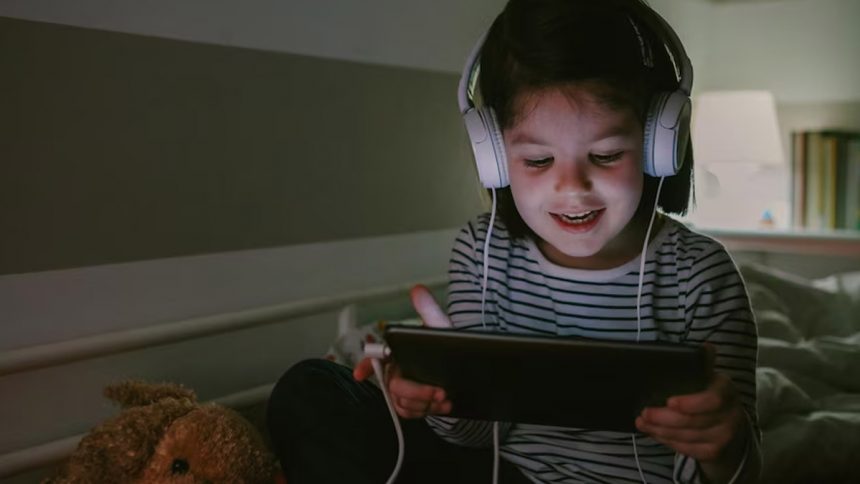Mobile game addiction among children is becoming an increasing concern for parents, educators, and health professionals. With greater smartphone accessibility and internet penetration, children are spending excessive hours on gaming apps, often at the cost of their studies, social interactions, and physical well-being. The addiction has led to behavioral changes such as aggression, anxiety, and sleep disorders. Experts warn that if left unchecked, this issue could have long-term psychological and academic consequences. Let’s explore the growing trend of mobile gaming addiction among children, its impact, and potential solutions.
Understanding gaming addiction
Dr. Mohd Abrar Guroo, Senior Consultant (Tele MANAS) at the Institute of Mental Health and Neurosciences (IMHANS) Srinagar, describes mobile game addiction as a compulsive mental and behavioral disorder where gaming disrupts a child’s daily life, responsibilities, and relationships.
“I have treated children who become so consumed by gaming that they neglect basic needs like eating, sleeping, or studying. The brain’s reward system plays a key role in this. Gaming triggers dopamine (the ‘happy hormone’), reinforcing the behavior and creating a cycle of dependency. Over time, the child may prioritize gaming above all else and struggle to stop despite negative consequences,” he said.
Dr. Guroo has observed the physical toll of gaming addiction in many young patients. Children often suffer from neck and back pain due to poor posture, eye strain from prolonged screen exposure, and even obesity due to reduced physical activity.
“Mentally, the effects can be profound. Many children develop heightened levels of anxiety and depression, often feeling irritable or restless when they aren’t gaming,” he added.
According to experts, gaming addiction can also disrupt sleep, leading to chronic fatigue and poor emotional regulation. In severe cases, children may isolate themselves, withdrawing from meaningful relationships and real-world interactions.
Recognizing early signs of gaming addiction
Dr. Guroo advises parents to recognize subtle warning signs early, such as:
· Frequent arguments over gaming time
· Sneaking extra playtime
· Frustration or aggression when gaming is interrupted
· Lying about gaming hours
· Neglecting homework, chores, or social activities
· Emotional withdrawal from hobbies and family interactions
“One of the most concerning effects I have observed is the deterioration of social skills. Children addicted to gaming often replace real-life interactions with virtual ones, leading to underdeveloped communication skills and difficulty forming meaningful relationships. Academically, the impact is equally alarming, with declining grades, missed assignments, and difficulty concentrating in class,” he said.
Factors contributing to gaming addiction
Several factors make children particularly vulnerable to gaming addiction.
1. Game Design: Most games are deliberately designed to be addictive, using reward systems and endless levels to keep players engaged.
2. Social Validation: Multiplayer games provide a sense of belonging, making children more likely to spend hours playing with friends online.
3. Escape from Stress: Academic pressure, family conflicts, or emotional distress can push children toward gaming as a coping mechanism.
4. Underlying Mental Health Conditions: Children with ADHD, anxiety, or other psychological conditions are more susceptible to addiction, as gaming offers temporary relief from their symptoms.
Dr. Guroo suggests that parents establish clear boundaries, such as device-free meals and screen-free hours before bedtime. While parental control apps can help, he emphasizes that open communication is the most effective strategy.
“I have seen cases where gaming behaviors transition into gambling-like tendencies. Many games include loot boxes or microtransactions, which mimic gambling by offering random rewards. Some of my adolescent patients have admitted to spending large sums of money on these features without fully understanding the consequences. This is a growing concern that requires stricter regulations and greater parental awareness,” he added.
Strategies for prevention and intervention
Dr. Guroo encourages parents to create structured routines that incorporate offline activities. Engaging children in hobbies like sports, art, or music provides healthier alternatives to gaming. Family activities such as board games, cooking, or outdoor adventures can strengthen relationships and reduce screen dependence.
He also stresses that parents should model balanced screen usage. “When children see their parents maintaining a healthy relationship with technology, they are more likely to follow.”
Certain types of games pose a higher risk of addiction, particularly those with immersive storylines, endless progression systems, or competitive multiplayer modes. Games with gambling-like features—such as randomized rewards and pay-to-win mechanisms—are especially harmful, as they exploit psychological vulnerabilities and make it difficult for children to disengage.
“When discussing gaming limits with children, I always recommend a collaborative approach. Instead of imposing rules, involve the child in the conversation and explain the reasons behind the restrictions. Highlight how reducing gaming time can improve their sleep, mood, and focus. Setting goals together—such as scheduling specific gaming hours and balancing them with other activities—creates a sense of ownership and reduces resistance,” he advised.
The role of schools
Schools play a crucial role in addressing gaming addiction. Dr. Guroo emphasizes the importance of promoting digital literacy and educating students on healthy screen habits.
“Schools can offer workshops for students and parents, focusing on the risks of excessive gaming and strategies for maintaining balance. Extracurricular programs like sports or clubs can encourage offline engagement. Teachers and counselors should remain vigilant for signs of gaming addiction, such as declining academic performance or social withdrawal, and work with families to intervene early,” he said.
Therapeutic and technological interventions
For children struggling with gaming addiction, early consultation with a psychiatrist is often necessary. Cognitive-behavioral therapy (CBT) helps children identify triggers for their gaming behavior and develop healthier coping strategies.
“Mindfulness techniques, such as meditation or deep breathing exercises, can also help reduce the stress that drives excessive gaming. Technological tools like screen-time trackers or apps that block certain games during designated hours can support parents in setting boundaries. In severe cases, a combination of medication and counseling may be required,” Dr. Guroo said.
Smartphone addiction: A growing concern
Dr. Suhail Naik, Assistant Professor at New Children Hospital, GMC Srinagar, highlights that smartphone addiction is a widespread yet often unrecognized problem affecting both children and adults.
“Smartphone addiction is similar to drug addiction. People experience intense psychological and physical symptoms when their phone is taken away, or when there is no network or internet access. Symptoms include restlessness, irritability, excessive crying, anger, tension, fatigue, and loss of appetite,” he explained.
He cited a study published in Frontiers in Psychiatry, which found that adolescents under 20 are the most at-risk for smartphone addiction, as they have yet to develop strong self-control skills.
Dr. Naik referenced the American Academy of Pediatrics’ guidelines, which recommend zero screen time for children under two and a maximum of one hour per day for children above two. “Unfortunately, many parents use smartphones as a tool to calm or distract their children, inadvertently encouraging addiction.”
The path to recovery
Medical research has shown that smartphone addiction alters brain structure, similar to substance use disorders. However, treatment options are available, including digital detox programs and specialized addiction centers.
Dr. Naik advises parents to actively manage their child’s screen time by encouraging outdoor play and physical activities.
“If excessive screen time is a concern, consider setting restrictions. Engaging in activities together ensures that physical play remains fun and stimulating. The goal is to create a balanced, healthy childhood,” he said.
As mobile gaming and smartphone addiction continue to rise among children, awareness, early intervention, and a proactive approach from both parents and educators are key to mitigating its harmful effects.









